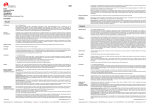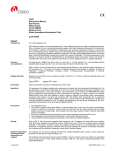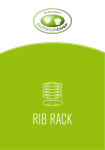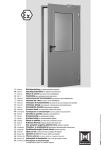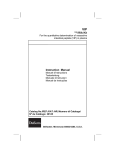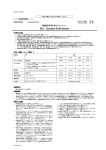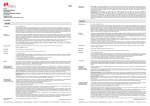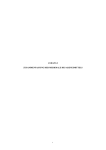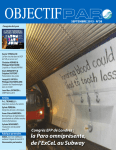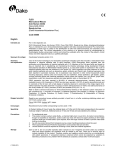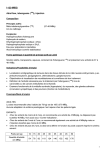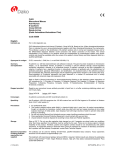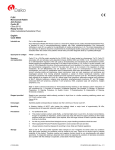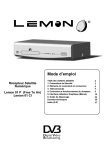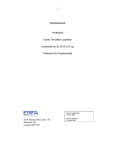Download Monoclonal Mouse
Transcript
FLEX Polyclonal Guinea Pig Anti-Insulin Ready-to-Use (Dako Autostainer/Autostainer Plus) Code IS002 Intended use For in vitro diagnostic use. FLEX Polyclonal Guinea Pig Anti-Insulin, Ready-to-Use (Dako Autostainer/Autostainer Plus), is intended for use in immunohistochemistry together with Dako Autostainer/Autostainer Plus instruments. This antibody labels insulin and insulin-producing cells in normal and neoplastic tissue. The clinical interpretation of any staining or its absence should be complemented by morphological studies using proper controls and should be evaluated within the context of the patient's clinical history and other diagnostic tests by a qualified pathologist. Summary and explanation Insulin is one of seven known polypeptide hormones produced in the pancreas. Insulin, secreted by B-cells of the islets of Langerhans, participates in glucose utilization, protein synthesis and in the formation and storage of neutral lipids (1). For more information on insulin detection and pancreatic tumors, please see references (2-7). Refer to Dako’s General Instructions for Immunohistochemical Staining or the detection system instructions of IHC procedures for: 1) Principle of Procedure, 2) Materials Required, Not Supplied, 3) Storage, 4) Specimen Preparation, 5) Staining Procedure, 6) Quality Control, 7) Troubleshooting, 8) Interpretation of Staining, 9) General Limitations. Reagent provided Ready-to-use polyclonal guinea pig antibody provided in liquid form in a buffer containing stabilizing protein and 0.015 mol/L sodium azide. Immunogen Porcine pancreatic insulin. Specificity The antibody cross-reacts with insulin from several mammalian species. Specificity as determined by radioimmunoassay was 100% for human insulin, 100% for porcine insulin and less than 0.05% for glucagon and human growth hormone. This product has been optimized for use on human tissues. Precautions 1. 2. 3. 4. 5. For professional users. This product contains sodium azide (NaN3), a chemical highly toxic in pure form. At product concentrations, though not classified as hazardous, sodium azide may react with lead and copper plumbing to form highly explosive build-ups of metal azides. Upon disposal, flush with large volumes of water to prevent metal azide build-up in plumbing. As with any product derived from biological sources, proper handling procedures should be used. Wear appropriate Personal Protective Equipment to avoid contact with eyes and skin. Unused solution should be disposed of according to local, State and Federal regulations. Storage Store at 2-8 °C. Do not use after expiration date stamped on vial. If reagents are stored under any conditions other than those specified, the conditions must be verified by the user. There are no obvious signs to indicate instability of this product. Therefore, positive and negative controls should be run simultaneously with patient specimens. If unexpected staining is observed which cannot be explained by variations in laboratory procedures and a problem with the antibody is suspected, contact Dako Technical Support. Specimen preparation including materials required but not supplied The antibody can be used for labeling formalin-fixed, paraffin-embedded tissue sections. Tissue specimens should be cut into sections of approximately 4 µm. Pre-treatment with heat-induced epitope retrieval (HIER) is required. Optimal results are obtained by pretreating tissues using EnVision FLEX Target Retrieval Solution, High pH (10x), (Dako Autostainer/Autostainer Plus) (Code K8010/K8014). Deparaffinized sections: Pre-treatment of deparaffinized formalin-fixed, paraffin-embedded tissue sections is recommended using Dako PT Link (Code PT100/PT101). For details, please refer to the PT Link User Guide. Follow the pre-treatment procedure outlined in the package insert for EnVision FLEX Target Retrieval Solution, High pH (10x), (Dako Autostainer/Autostainer Plus) (Code K8010/K8014). The following parameters should be used for PT Link: Pre-heat temperature: 65 °C; epitope retrieval temperature and time: 97 °C for 20 (±1) minutes; cool down to 65 °C. Remove Autostainer slide rack with slides from the PT Link tank and immediately dip slides into a jar/tank (e.g., PT Link Rinse Station, Code PT109) containing diluted room temperature EnVision FLEX Wash Buffer (10x), (Dako Autostainer/Autostainer Plus) (Code K8010). Leave slides in Wash Buffer for 1-5 minutes. Paraffin-embedded sections: As alternative specimen preparation, both deparaffinization and epitope retrieval can be performed in the PT Link using a modified procedure. See the PT Link User Guide for instructions. After the staining procedure has been completed, the sections must be dehydrated, cleared and mounted using permanent mounting medium. (118549-001) 307692EFG_001 p. 1/6 The tissue sections should not dry out during the treatment or during the following immunohistochemical staining procedure. For greater adherence of tissue sections to glass slides, the use of Dako Silanized Slides (Code S3003) is recommended. Staining procedure including materials required but not supplied The recommended visualization system is EnVision FLEX, High pH, (Dako Autostainer/Autostainer Plus) (Code K8010). The staining steps and incubation times are pre-programmed into the software of Dako Autostainer/Autostainer Plus instruments, using the following protocols: Template protocol: FLEXRTU2 (200 µL dispense volume) or FLEXRTU3 (300 µL dispense volume) Autoprogram: Insulin (without counterstaining) or InsulinH (with counterstaining) The Auxiliary step should be set to “rinse buffer” in staining runs with ≤10 slides. For staining runs with >10 slides the Auxiliary step should be set to “none”. This ascertains comparable wash times. All incubation steps should be performed at room temperature. For details, please refer to the Operator’s Manual for the dedicated instrument. If the protocols are not available on the used Dako Autostainer instrument, please contact Dako Technical Services. Optimal conditions may vary depending on specimen and preparation methods, and should be determined by each individual laboratory. If the evaluating pathologist should desire a different staining intensity, a Dako Application Specialist/Technical Service Specialist can be contacted for information on re-programming of the protocol. Verify that the performance of the adjusted protocol is still valid by evaluating that the staining pattern is identical to the staining pattern described in “Performance characteristics”. Counterstaining in hematoxylin is recommended using EnVision FLEX Hematoxylin, (Dako Autostainer/Autostainer Plus) (Code K8018). Non-aqueous, permanent mounting medium is recommended. Positive and negative controls should be run simultaneously using the same protocol as the patient specimens. The positive control tissue should include pancreas and the cells/structures should display reaction patterns as described for this tissue in “Performance characteristics” in all positive specimens. The recommended negative control reagent is FLEX Negative Control, Rabbit, (Dako Autostainer/Autostainer Plus) (Code IS600). Staining interpretation The cellular staining pattern is cytoplasmic. Performance characteristics Normal tissues: This antibody labels the cytoplasm of insulin-producing B cells. Approximately 60–80% of normal islet cells are B cells. Abnormal tissues: Insulin-producing islet cell tumors, hyperplastic islet cells and islet cells originating in pancreatic ductules were labeled (8). Mesenchymal tumors are not labeled. Français Réf. IS002 Utilisation prévue Pour utilisation diagnostique in vitro. L’anticorps FLEX Polyclonal Guinea Pig Anti-Insulin, Ready-to-Use (Dako Autostainer/Autostainer Plus), est destiné à être utilisé en immunohistochimie avec les appareils Dako Autostainer/Autostainer Plus. Cet anticorps marque l’insuline ainsi que les cellules productrices d’insuline dans les tissus sains et néoplasiques. L’interprétation clinique de toute coloration ou son absence doit être complétée par des études morphologiques en utilisant des contrôles appropriés et doit être évaluée en fonction des antécédents cliniques du patient et d’autres tests diagnostiques par un pathologiste qualifié. Résumé et explication L’insuline est l’une des sept hormones polypeptidiques connues produites par le pancréas. L’insuline, sécrétée par les cellules B des îlots de Langerhans, participe à l’utilisation du glucose, à la synthèse des protéines ainsi qu’à la formation et au stockage des lipides neutres (1). Pour plus d’informations sur la détection de l’insuline et les tumeurs du pancréas, consulter la section « Bibliographie » (2-7). Se reporter aux « Instructions générales de coloration immunohistochimique » de Dako ou aux instructions du système de détection relatives aux procédures IHC pour plus d’informations concernant les points suivants : 1) Principe de procédure, 2) Matériels requis, mais non fournis, 3) Conservation, 4) Préparation des échantillons, 5) Procédure de coloration, 6) Contrôle qualité, 7) Dépannage, 8) Interprétation de la coloration, 9) Limites générales. Réactifs fournis Anticorps polyclonal de cobaye prêt à l’emploi fourni sous forme liquide dans un tampon contenant une protéine stabilisante et 0,015 mol/L d’azide de sodium. Immunogène Insuline extraite de pancréas de porc. Spécificité L’anticorps présente une réaction croisée avec l’insuline provenant de plusieurs espèces de mammifères. La spécificité, déterminée par radioimmunodosage, était de 100 % pour l’insuline humaine, de 100 % pour l’insuline de porc et de moins de 0,05 % pour le glucagon et l’hormone de croissance humaine. Ce produit a été optimisé pour être utilisé sur des tissus humains. (118549-001) 307692EFG_001 p. 2/6 Précautions 1. 2. 3. 4. 5. Pour utilisateurs professionnels. Ce produit contient de l’azide de sodium (NaN3), un produit chimique hautement toxique sous sa forme pure. Aux concentrations du produit, bien que non classé comme dangereux, l’azide de sodium peut réagir avec le cuivre et le plomb des canalisations et former des accumulations d’azides métalliques hautement explosifs. Lors de l’élimination, rincer abondamment à l’eau pour éviter toute accumulation d’azide métallique dans les canalisations. Comme avec tout produit d’origine biologique, des procédures de manipulation appropriées doivent être respectées. Porter un vêtement de protection approprié pour éviter le contact avec les yeux et la peau. Les solutions non utilisées doivent être éliminées conformément aux réglementations locales et nationales. Conservation Conserver entre 2 et 8 °C. Ne pas utiliser après la date limite de péremption indiquée sur le flacon. Si les réactifs sont conservés dans des conditions autres que celles indiquées, celles-ci doivent être validées par l’utilisateur. Il n’y a aucun signe évident indiquant l’instabilité de ce produit. Par conséquent, des contrôles positifs et négatifs doivent être testés en même temps que les échantillons de patients. Si une coloration inattendue est observée, qui ne peut être expliquée par un changement des procédures du laboratoire, et en cas de suspicion d’un problème lié à l’anticorps, contacter l’assistance technique de Dako. Préparation des échantillons y compris le matériel requis mais non fourni L’anticorps peut être utilisé pour le marquage des coupes de tissus inclus en paraffine et fixés au formol. L’épaisseur des coupes d’échantillons de tissu doit être d’environ 4 µm. Le prétraitement avec un démasquage d’épitope induit par la chaleur (HIER) est nécessaire. Pour obtenir des résultats optimaux, prétraiter les tissus à l’aide du produit EnVision FLEX Target Retrieval Solution, High pH (10x), (Dako Autostainer/Autostainer Plus) (réf. K8010/K8014). Coupes déparaffinées : Il est recommandé de prétraiter les coupes de tissus fixés au formol et inclus en paraffine qui ont été déparaffinées à l’aide de l’appareil PT Link de Dako (réf. PT100/PT101). Pour plus de détails, se reporter au Guide d’utilisation du PT Link. Suivre la procédure de prétraitement indiquée dans la notice du produit EnVision FLEX Target Retrieval Solution, High pH (10x), (Dako Autostainer/Autostainer Plus) (réf. K8010/K8014). Les paramètres suivants doivent être utilisés pour le PT Link : température de préchauffage : 65 °C ; température et durée du démasquage d’épitope : 97 °C pendant 20 (±1) minutes ; refroidissement jusqu’à 65 °C. Retirer le portoir à lames Autostainer contenant les lames de la cuve du PT Link et plonger immédiatement les lames dans un récipient/une cuve (par ex., station de rinçage du PT Link, réf. PT109) contenant du tampon de lavage EnVision FLEX Wash Buffer (10x), (Dako Autostainer/Autostainer Plus) (réf. K8010) dilué à température ambiante. Laisser les lames dans le tampon de lavage pendant 1 à 5 minutes. Coupes incluses en paraffine : Comme préparation alternative des échantillons, le déparaffinage et le démasquage d’épitope peuvent être réalisés dans l’appareil PT Link en utilisant une procédure modifiée. Consulter le Guide d’utilisation du PT Link pour obtenir des instructions. Une fois que la procédure de coloration est terminée, les coupes doivent être déshydratées, éclaircies et montées à l’aide d’un milieu de montage permanent. Les coupes de tissus ne doivent pas sécher lors du traitement ni lors de la procédure de coloration immunohistochimique suivante. Pour une meilleure adhérence des coupes de tissus sur les lames de verre, il est recommandé d’utiliser des lames Dako Silanized Slides (réf. S3003). Procédure de coloration y compris le matériel requis mais non fourni Le système de visualisation recommandé est le système EnVision FLEX, High pH, (Dako Autostainer/Autostainer Plus) (réf. K8010). Les étapes de coloration et les temps d’incubation sont préprogrammés dans le logiciel des appareils Dako Autostainer/Autostainer Plus, à l’aide des protocoles suivants : Protocole modèle : FLEXRTU2 (volume de distribution de 200 µL) ou FLEXRTU3 (volume de distribution de 300 µL) Programme automatique : Insulin (sans contre-coloration) ou InsulinH (avec contre-coloration) L’étape Auxiliary doit être réglée sur « rinse buffer » lors des cycles de coloration avec ≤10 lames. Pour les cycles de coloration de >10 lames, l’étape Auxiliary doit être réglée sur « none ». Cela confirme des temps de lavage comparables. Toutes les étapes d’incubation doivent être effectuées à température ambiante. Pour plus de détails, se reporter au Manuel de l’opérateur spécifique à l'appareil. Si les protocoles ne sont pas disponibles sur l’appareil Dako Autostainer utilisé, contacter l’assistance technique de Dako. Les conditions optimales peuvent varier en fonction du prélèvement et des méthodes de préparation, et doivent être déterminées par chaque laboratoire individuellement. Si le pathologiste qui réalise l’évaluation désire une intensité de coloration différente, un ingénieur d’application/un spécialiste de l’assistance technique de Dako peut être contacté pour obtenir des informations sur la reprogrammation du protocole. Vérifier que les performances du protocole modifié sont toujours valides en vérifiant que le schéma de coloration est identique au schéma de coloration décrit à la section « Caractéristiques de performance ». Il est recommandé d’effectuer une contre-coloration à l’hématoxyline à l’aide du produit EnVision FLEX Hematoxylin, (Dako Autostainer/Autostainer Plus) (réf. K8018). L’utilisation d’un milieu de montage permanent non aqueux est recommandée. Des contrôles positifs et négatifs doivent être testés en même temps et avec le même protocole que les échantillons de patients. Le tissu de contrôle positif doit comprendre le pancréas et les cellules/structures doivent présenter des schémas de réaction semblables à ceux décrits pour ce tissu à la section « Caractéristiques de performance » pour tous les échantillons positifs. Le réactif de contrôle négatif recommandé est le produit FLEX Negative Control, Rabbit, (Dako Autostainer/Autostainer Plus) (réf. IS600). (118549-001) 307692EFG_001 p. 3/6 Interprétation de la coloration Le schéma de coloration cellulaire est cytoplasmique. Caractéristiques de performance Tissus sains : Cet anticorps marque le cytoplasme des cellules B productrices d’insuline. Environ 60 à 80 % des cellules des îlots sains sont des cellules B. Tissus tumoraux : Les tumeurs des cellules des îlots productrices d'insuline, les cellules des îlots hyperplasiques et les cellules des îlots provenant des ductules du pancréas étaient marquées (8). Les tumeurs mésenchymateuses ne sont pas marquées. Deutsch Code-Nr. IS002 Zweckbestimmung Zur In-vitro-Diagnostik. FLEX Polyclonal Guinea Pig Anti-Insulin, Ready-to-Use (Dako Autostainer/Autostainer Plus) ist zur Verwendung in der Immunhistochemie in Verbindung mit Dako Autostainer/Autostainer Plus-Geräten bestimmt. Dieser Antikörper markiert Insulin und Insulin-produzierende Zellen in normalem und neoplastischem Gewebe. Die klinische Auswertung einer eventuell eintretenden Färbung sollte durch morphologische Studien mit geeigneten Kontrollen ergänzt werden und von einem qualifizierten Pathologen unter Berücksichtigung der Krankengeschichte und anderer diagnostischer Tests des Patienten vorgenommen werden. Zusammenfassung und Erklärung Insulin ist eines von sieben bekannten Polypeptidhormonen, die in der Bauchspeicheldrüse gebildet werden. Insulin, das von den B-Zellen der Langerhans-Inselzellen sekretiert wird, ist am Glukosestoffwechsel, an der Proteinsynthese und an der Bildung und Speicherung von Neutrallipiden (1) beteiligt. Weitere Informationen zum Insulinnachweis und zu pankreatischen Tumoren sind in den Literaturangaben 2–7 enthalten. Folgende Angaben bitte den Allgemeinen Richtlinien zur immunhistochemischen Färbung von Dako bzw. den Anweisungen des Detektionssystems für IHC-Verfahren entnehmen: 1) Verfahrensprinzip, 2) Erforderliche, aber nicht mitgelieferte Materialien, 3) Aufbewahrung, 4) Vorbereitung der Probe, 5) Färbeverfahren, 6) Qualitätskontrolle, 7) Fehlersuche und -behebung, 8) Auswertung der Färbung, 9) Allgemeine Beschränkungen. Geliefertes Reagenz Gebrauchsfertiger polyklonaler Meerschweinchen-Antikörper in flüssiger Form in einem Puffer, der stabilisierendes Protein und 0,015 mol/L Natriumazid enthält. Immunogen Insulin aus der Bauchspeicheldrüse des Schweins. Spezifität Der Antikörper weist bei mehreren Säugetierspezies eine Kreuzreaktion mit Insulin auf. Die mittels eines Radioimmunassays ermittelte Spezifität lag bei 100 % für Humaninsulin, 100 % für Schweineinsulin und weniger als 0,05 % für Glukagon und humanes Wachstumshormon. Dieses Produkt wurde für die Verwendung mit Humangewebe optimiert. Vorsichtsmaßnahmen 1. 2. 3. 4. 5. Lagerung (118549-001) Für Fachpersonal. Dieses Produkt enthält Natriumazid (NaN3), eine in reiner Form äußerst giftige Chemikalie. Natriumazid kann auch in als ungefährlich eingestuften Konzentrationen mit Blei- und Kupferrohren reagieren und hochexplosive Metallazide bilden. Nach der Entsorgung stets mit viel Wasser nachspülen, um Metallazidansammlungen in den Leitungen vorzubeugen. Wie alle Produkte biologischen Ursprungs müssen auch diese entsprechend gehandhabt werden. Geeignete Schutzkleidung tragen, um Augen- und Hautkontakt zu vermeiden. Nicht verwendete Lösung ist entsprechend örtlichen, bundesstaatlichen und staatlichen Richtlinien zu entsorgen. Bei 2–8 °C aufbewahren. Nach Ablauf des auf dem Fläschchen aufgedruckten Verfallsdatums nicht mehr verwenden. Werden die Reagenzien nicht entsprechend den angegebenen Bedingungen aufbewahrt, müssen die Bedingungen vom Anwender geprüft werden. Es gibt keine offensichtlichen Anzeichen für eine eventuelle Produktinstabilität. Positiv- und Negativkontrollen sollten daher zur gleichen Zeit wie die Patientenproben getestet werden. Falls es zu einer unerwarteten Färbung kommt, die sich nicht durch Unterschiede bei Laborverfahren erklären lässt und auf ein Problem mit dem Antikörper hindeutet, ist der technische Kundendienst von Dako zu verständigen. 307692EFG_001 p. 4/6 Vorbereitung der Probe und erforderliche, aber nicht mitgelieferte Materialien Der Antikörper eignet sich zur Markierung von formalinfixierten und paraffineingebetteten Gewebeschnitten. Gewebeproben sollten in Schnitte von ca. 4 µm Stärke geschnitten werden. Es ist eine Vorbehandlung durch hitzeinduzierte Epitopdemaskierung (HIER-Verfahren) erforderlich. Optimale Ergebnisse können durch Vorbehandlung der Gewebe mit EnVision FLEX Target Retrieval Solution, High pH (10x), (Dako Autostainer/Autostainer Plus) (Code-Nr. K8010/K8014) erzielt werden. Entparaffinierte Schnitte: Die Vorbehandlung entparaffinierter formalinfixierter, paraffineingebetteter Gewebeschnitte sollte mit dem System Dako PT Link (Code-Nr. PT100/PT101) erfolgen. Weitere Informationen hierzu: siehe PT Link-Benutzerhandbuch. Vorbehandlung gemäß der Beschreibung in der Packungsbeilage für EnVision FLEX Target Retrieval Solution, High pH (10x), (Dako Autostainer/Autostainer Plus) (Code-Nr. K8010/K8014) durchführen. Für das PT LinkSystem sollten die folgenden Parameter verwendet werden: Vorwärmtemperatur: 65 °C; Temperatur und Zeit für Epitopdemaskierung: 97 °C für 20 (±1) Minuten; auf 65 °C abkühlen. Das Autostainer Objektträgergestell mit den Objektträgern aus dem PT Link-Behälter herausnehmen und die Objektträger sofort in einen Behälter (z. B. PT Link Rinse Station, Code-Nr. PT109) mit verdünntem, auf Zimmertemperatur gebrachtem EnVision FLEX Wash Buffer (10x), (Dako Autostainer/Autostainer Plus) (Code-Nr. K8010) eintauchen. Die Objektträger für 1–5 Minuten im Waschpuffer belassen. Paraffineingebettete Schnitte: Alternativ können Entparaffinierung und Epitopdemaskierung im PT Link unter Verwendung eines modifizierten Verfahrens durchgeführt werden. Weitere Informationen finden Sie im PT LinkBenutzerhandbuch. Nach Abschluss des Färbeverfahrens müssen die Schnitte dehydriert, geklärt und unter Verwendung eines permanenten Fixiermittels auf die Objektträger aufgebracht werden. Die Gewebeschnitte dürfen während der Behandlung oder während des anschließenden immunhistochemischen Färbeverfahrens nicht austrocknen. Zur besseren Haftung der Gewebeschnitte an den Glasobjektträgern wird die Verwendung von Dako Silanized Slides (Code-Nr. S3003) empfohlen. Färbeverfahren und erforderliche, aber nicht mitgelieferte Materialien Das empfohlene Visualisierungssystem ist EnVision FLEX, High pH, (Dako Autostainer/Autostainer Plus) (Code-Nr. K8010). Die Färbeschritte und Inkubationszeiten sind in der Software von Autostainer Dako Autostainer/Autostainer Plus-Geräten mit den folgenden Protokollen vorprogrammiert: Matrix-Protokoll: FLEXRTU2 (200 µl Anwendungsvolumen) oder FLEXRTU3 (300 µl Anwendungsvolumen) Autoprogramm: Insulin (ohne Gegenfärbung) oder InsulinH (mit Gegenfärbung) Bei Färbedurchläufen mit höchstens 10 Objektträgern sollte der Zusatz-Schritt auf „Pufferspülgang“ eingestellt werden. Für Färbedurchläufe mit mehr als 10 Objektträgern den Zusatz-Schritt auf „Keine“ einstellen. Dies gewährleistet vergleichbare Waschzeiten. Alle Inkubationsschritte bei Raumtemperatur durchführen. Nähere Einzelheiten bitte dem Benutzerhandbuch für das jeweilige Gerät entnehmen. Wenn die Protokolle auf dem verwendeten Autostainer-Gerät nicht verfügbar sind, wenden Sie sich an den technischen Kundendienst von Dako. Optimale Bedingungen können je nach Probe und Präparationsverfahren unterschiedlich sein und sollten vom jeweiligen Labor selbst ermittelt werden. Falls der beurteilende Pathologe eine andere Färbungsintensität wünscht, kann ein Anwendungsspezialist oder Kundendiensttechniker von Dako bei der Neuprogrammierung des Protokolls helfen. Die Leistung des angepassten Protokolls muss verifiziert werden, indem gewährleistet wird, dass das Färbemuster mit dem unter „Leistungsmerkmale“ beschriebenen Färbemuster identisch ist. Die Gegenfärbung in Hämatoxylin sollte mit EnVision FLEX Hematoxylin, (Dako Autostainer/Autostainer Plus) (Code-Nr. K8018) ausgeführt werden. Empfohlen wird ein nichtwässriges, permanentes Fixiermittel. Positiv- und Negativkontrollen sollten zur gleichen Zeit und mit demselben Protokoll wie die Patientenproben getestet werden. Das positives Kontrollgewebe sollte Pankreaszellen enthalten, und die Zellen/Strukturen müssen in allen positiven Proben die für dieses Gewebe unter „Leistungsmerkmale“ beschriebenen Reaktionsmuster aufweisen. Das empfohlene negative Kontrollreagenz ist FLEX Negative Control, Rabbit (Dako Autostainer/Autostainer Plus) (Code-Nr. IS600). Auswertung der Färbung Das zelluläre Färbemuster ist zytoplasmatisch. Leistungsmerkmale Normale Gewebe: Dieser Antikörper markiert das Zytoplasma von Insulin-produzierenden B-Zellen. Ca. 60–80 % der normalen Inselzellen sind B-Zellen. Pathologische Gewebe: Markiert werden Insulin-produzierende Inselzelltumore, hyperplastische Inselzellen und aus den Ausführungsgängen des Pankreas stammende Insellzellen (8). Mesenchymale Tumore werden nicht markiert. (118549-001) 307692EFG_001 p. 5/6 References Bibliographie Literaturangaben 1. Sternberger LA. In: Immunocytochemistry, 2nd ed. New York: John Wiley and Sons 1979;8. 2. Heitz PU, Kasper M, Polak JM, Kloppel G. Pancreatic endocrine tumors: immunocytochemical analysis of 125 tumors. Hum Pathol 1982:13:263-71. 3. Creutzfeldt W. Endocrine tumors of the pancreas. In: Diabetic Pancreas. Bruno WE, et al., editors. New York: Plenum Press 1977:551. 4. Creutzfeldt W, et al. Insulinomas and gastrinomas. In: Gut Hormones. Bloom SR, Grossmann MI, editors. Edinburgh: Churchill Livingstone, 1978;96:589. 5. Creutzfeldt W. Endocrine tumors of the pancreas. Clinical, chemical and morphological findings. In Fitzgerald PJ, Morrison AB, editors. The Pancreas. Baltimore: William & Wilkins 1980;208. 6. 7. Larsson L. Endocrine pancreatic tumors. Hum Pathol 1978;9:401-16. Freisen SR. Tumors of the endocrine pancreas. N Eng J Med 1982; 306:580. 8. Weidenheim KM, Hinchey WW, Campell WG Jr. Hyperinsulinemic hypoglycemia in adults with islet-cell hyperplasia and degranulation of exocrine cells of the pancreas. Amer Clin Pathol 1983;79:14-24. Edition 04/08 (118549-001) 307692EFG_001 p. 6/6






